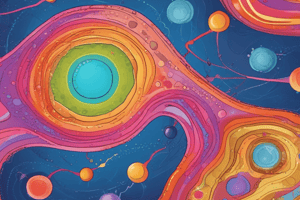Podcast
Questions and Answers
Fertilization is the process by which an egg fertilizes a sperm, resulting in the formation of a zygote.
Fertilization is the process by which an egg fertilizes a sperm, resulting in the formation of a zygote.
False (B)
Internal fertilization occurs outside the body of the female.
Internal fertilization occurs outside the body of the female.
False (B)
Sperm capacitation is the process by which an egg releases a signal to attract sperm.
Sperm capacitation is the process by which an egg releases a signal to attract sperm.
False (B)
The sperm and egg nuclei fuse to form a zygote during the sperm penetration stage.
The sperm and egg nuclei fuse to form a zygote during the sperm penetration stage.
Cleavage is the stage of embryonic development characterized by the formation of three primary layers.
Cleavage is the stage of embryonic development characterized by the formation of three primary layers.
Organogenesis is the stage of embryonic development characterized by significant growth and shaping into its final form.
Organogenesis is the stage of embryonic development characterized by significant growth and shaping into its final form.
The blastocyst is a stage in embryonic development characterized by the formation of a flat, disc-like structure.
The blastocyst is a stage in embryonic development characterized by the formation of a flat, disc-like structure.
Gastrula is a stage in embryonic development characterized by rapid cell division without significant growth.
Gastrula is a stage in embryonic development characterized by rapid cell division without significant growth.
Fertilization occurs outside the body of the female in animals.
Fertilization occurs outside the body of the female in animals.
Embryonic development is the process by which a sperm develops into a multicellular organism.
Embryonic development is the process by which a sperm develops into a multicellular organism.
Flashcards are hidden until you start studying
Study Notes
Fertilization
- Definition: The process by which a sperm fertilizes an egg, resulting in the formation of a zygote.
- Types of fertilization:
- Internal fertilization: Occurs within the body of the female, common in animals.
- External fertilization: Occurs outside the body of the female, common in fish and amphibians.
- Steps of fertilization:
- Sperm capacitation: Sperm undergoes changes to prepare for fertilization.
- Egg activation: The egg releases a signal to attract sperm.
- Sperm penetration: A sperm penetrates the egg's outer layer.
- Fusion of gametes: The sperm and egg nuclei fuse to form a zygote.
Embryonic Development
- Definition: The process by which a zygote develops into a multicellular organism.
- Stages of embryonic development:
- Cleavage: The zygote undergoes rapid cell division without significant growth.
- Gastrulation: The embryo undergoes a series of complex cellular movements, resulting in the formation of three primary layers: ectoderm, mesoderm, and endoderm.
- Organogenesis: The three primary layers differentiate into specific organs and tissues.
- Morphogenesis: The embryo undergoes significant growth and shapes into its final form.
- Important embryonic structures:
- Blastocyst: A stage in embryonic development characterized by a fluid-filled cavity and two distinct groups of cells.
- Gastrula: A stage in embryonic development characterized by the formation of three primary layers.
- Embryonic disc: A stage in embryonic development characterized by the formation of a flat, disc-like structure.
Fertilization
- Fertilization is the process by which a sperm fertilizes an egg, resulting in the formation of a zygote.
- There are two types of fertilization: internal and external.
- Internal fertilization occurs within the body of the female, common in animals.
- External fertilization occurs outside the body of the female, common in fish and amphibians.
- The steps of fertilization include:
- Sperm capacitation: Sperm undergoes changes to prepare for fertilization.
- Egg activation: The egg releases a signal to attract sperm.
- Sperm penetration: A sperm penetrates the egg's outer layer.
- Fusion of gametes: The sperm and egg nuclei fuse to form a zygote.
Embryonic Development
- Embryonic development is the process by which a zygote develops into a multicellular organism.
- There are four stages of embryonic development:
- Cleavage: The zygote undergoes rapid cell division without significant growth.
- Gastrulation: The embryo undergoes a series of complex cellular movements, resulting in the formation of three primary layers: ectoderm, mesoderm, and endoderm.
- Organogenesis: The three primary layers differentiate into specific organs and tissues.
- Morphogenesis: The embryo undergoes significant growth and shapes into its final form.
- Important embryonic structures include:
- Blastocyst: A stage in embryonic development characterized by a fluid-filled cavity and two distinct groups of cells.
- Gastrula: A stage in embryonic development characterized by the formation of three primary layers.
- Embryonic disc: A stage in embryonic development characterized by the formation of a flat, disc-like structure.
Studying That Suits You
Use AI to generate personalized quizzes and flashcards to suit your learning preferences.




